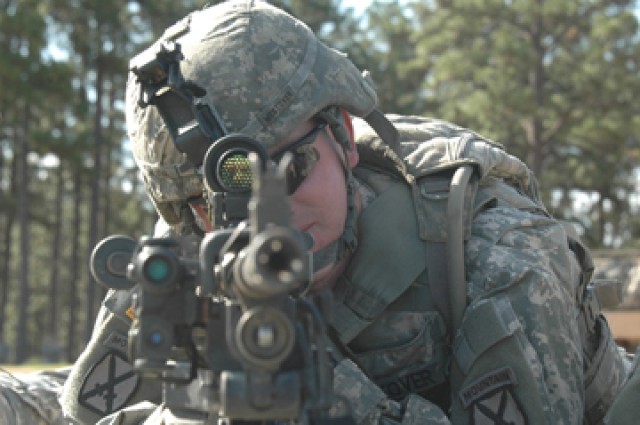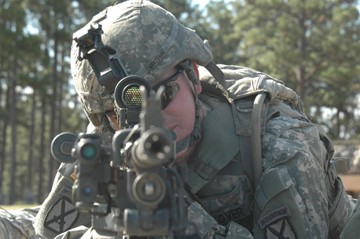FORT POLK, La. -- To hone their lethal-fires skills, 2nd Battalion, 30th Infantry Regiment, 4th Brigade Combat Team, 10th Mountain Division, conducted "School of the Gun" training from Sept. 28 to Oct. 2.
First Sgt. Heath Furbish, Company A, 2nd Bn, 30th Inf first sergeant, planned, resourced and executed the week-long course, which took two months to bring to reality. With few leaders and Soldiers experienced on the variety of weapons in the battalion, the need to develop lethal machine gun teams in the battalion was the main basis for the training, he said.
"It establishes the train the trainer for platoon sergeants and weapons leaders," said Furbish. "It is important that (leaders) know their jobs and how to train their Soldiers on the weapon systems."
Along with using the train the trainer method, Furbish said one-third of the Soldiers participating are relatively new Soldiers who have not fired the M240B weapon system, making the training all that more important.
"The training gives us some idea of what to do," said Spc. Roy Wasbotten, a truck driver assigned to Co F, 2nd Bn, 30th Inf. "It gives us more familiarization with the weapon systems."
The first day of training involved classroom instruction, allowing Soldiers to learn multiple aspects about the weapons they would be firing. Topics included the history and development of the M240B machine gun, theory and characteristics and math of machine guns.
Actual weapon firing was on tap for day two, which included day and night weapons qualifications conducted on a range just outside Fort Polk. Soldiers faced challenges including zeroing and qualifying the M240B and performing transition fires on 200- to 800-meter targets during the day. That night, the Soldiers qualified on 200- to 400-meter targets and field zeroed their weapons. Day three brought along qualifying for the Soldiers, with day four providing plenty of tasks to complete.
"The Soldiers conducted crew drills," said Furbish. "They also participated in day and night live fires." Furbish said the crew drills consisted of a gunner, assistant gunner and ammunition-bearing support Soldier. The crews went through various scenarios, including the gunner being "taken out" and the assistant gunner having to roll the gunner over and assume the firing position on the enemy.
On day five, the Soldiers endured a stress shoot in three-man teams. One of the Soldiers carried the M240B, another a bipod, and the other carried 900 rounds of ammunition in his rucksack. Once they received their scenario, they sprinted between 800 and 900 meters to a firing position, where they received instructions from a non-commissioned officer, who was also their grader for this timed event. A team's time began when they got to the start line after receiving their orders and ended when they finished all five firing lanes. Graders scored teams based on their finishing time and how many engaged targets were hit.
The Soldiers moved from station to station firing on assigned targets and going through combat scenarios. The stress shoot created a challenge for the Soldiers.
"We didn't want to (just) go through the motions," said Sgt. Kendall Spataro, motor sergeant, Co F. "You always want to do good in a competition. I think we did pretty well."
Spataro and his Soldiers had a lot to prove, being from a support company that does not necessarily participate in field exercises as much as their infantrymen comrades.
"We were motivated because the infantry guys were talking 'smack,'" said Spc. Alexander Huble, a Co F truck driver. "They know we don't shoot weapons a lot; it was a good competition."
Even after the stress shoot, the Soldiers were not done. They repeated the same stress shoot at night, then took a written exam featuring questions based on the training they received.
Once the training was complete, Soldiers received something they could take back to their companies to use down the line.
"The leaders and Soldiers can take this knowledge back to the company level," said Furbish. He encouraged the companies in the battalion to develop training plans and have them come back together again to see how much they have learned and retained from this week of training.
With a probable deployment in the coming year, 2nd Bn, 30th Inf Soldiers and leaders know they must be prepared for anything that comes their way.
"The enemy knows their weapon systems and uses their terrain very well," said Furbish. "Soldiers and leaders need to understand the true lethality of the weapon systems they are using."


Social Sharing